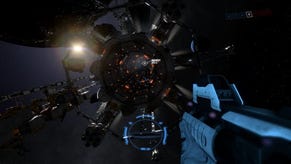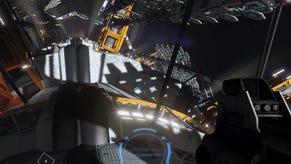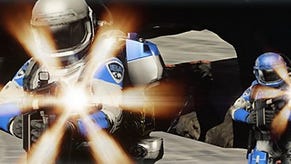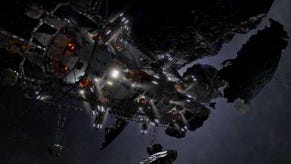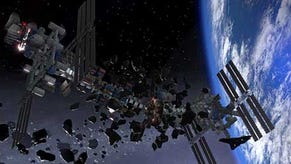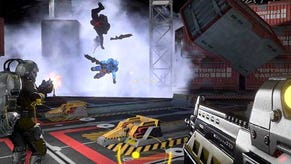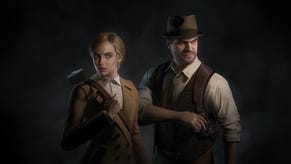Futuremark Talk Shattered Horizon
Earlier this week we spoke to Antti Summala, the lead designer on astronaut shooter, Shattered Horizon. The resulting interview covers a bunch of topics, including the advantages of self-publishing, the reasoning behind making the game DirectX 10 only, and the problems of control systems when there is no universal up or down. The game itself is out on Steam for €20/$20/£15 on the 4th of November. Read on for a peek into Futuremark's adventures in near-future sci-fi.
RPS: Can you tell us a little about the background of the Futuremark Games Studio? Obviously lots of gamers are familiar with the benchmarking software, but how did this move into full-blown game development come about?
Summala: Futuremark was founded in 1997 as a spin-off from Remedy Entertainment. Futuremark’s focus has always been advanced real-time gaming graphics. For the last 10 years we’ve been making 3DMark, a 3D graphics benchmark for gamers, creating a new version with each step up in DirectX.
Many of our artists and programmers have backgrounds in the Finnish demo scene. For 10 years they’ve been pretty vocal in pushing us to make our own game. We set up Futuremark Games Studio in January 2008 because the timing finally seemed right. 3DMark Vantage, our latest DirectX10 benchmark, gave us a solid rendering engine we could use as the basis for the engine. So we took the plunge, launched the studio and announced to the world that Futuremark was going to make a game.
RPS: Can you explain a bit about how you settled on Shattered Horizon's concept? Was it slowly evolved, or was there a single idea that you just had to turn into a game? How did it come about?
Summala: Although the studio was officially created in January 2008 the idea for a zero gravity shooter had been floating around for a while, so to speak. With the launch of the studio we refined the concept and then started designing the game and building the extra technology we would need to make it work.
Shattered Horizon is our first game so we decided we would go multiplayer-only very early on. A multiplayer game is orders of magnitude simpler and less costly to produce, which still doesn’t make it easy but it helps make the project manageable.
Our main design aim was to make zero gravity fun. We had the feeling that extra freedom of movement would allow players to create new and interesting tactics that they wouldn’t have experienced in other games. And making the game an FPS would give it a different feel from the space sims with six degrees of freedom where you control a ship, rather than a player.
RPS: The technical specifications for Shattered Horizon are quite high - was it your intention to make something that would stretch a PC's capabilities? The graphically demanding PC game seems like a rare breed these days, so was that intentional?
Summala: I don’t think anyone was surprised to hear that Futuremark is one of the first to release a DirectX10 only game as we’ve always been forward looking when to comes to graphics. When we started making Shattered Horizon we placed some bets on where PC gaming technology was going. We’ve been watching the Steam hardware survey pretty closely and of course we have tons of hardware data from our benchmark users.
With Windows 7 launching just last week and some very affordable DirectX 10 and 11 cards entering the market we’re very happy with being DirectX 10 only. As we are self-publishing Shattered Horizon on Steam we don’t have the same restrictions and pressures facing the big publishers. We don’t have to make compromises to chase the largest possible market and because Shattered Horizon is a PC exclusive we’re not limited by a common technology platform that has to accommodate the consoles.
The specs are quite high but they are also fair and accurate. Even with the minimum hardware you should get a solid 30 frames a second and graphics that are still very presentable.
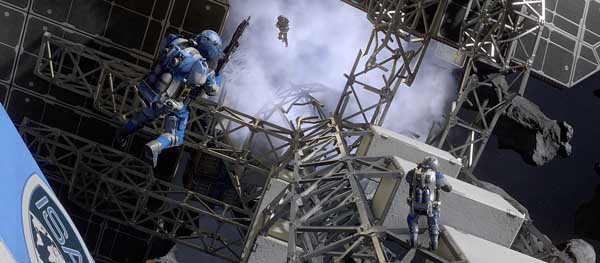
RPS: Can you tell us a bit about the design challenges that you faced when making Shattered Horizon? Was there one thing that really made the process difficult?
Summala: Shattered Horizon is our first full game so the development process had its fair share of ups and downs. We are using an in-house engine and developing tools alongside the game gave us quite a few headaches.
In terms of the game design two things stand out. The first was a goal that giving the player complete freedom of movement shouldn’t come at the expense of overwhelming complexity. We knew that a key part of making zero gravity fun would be making it accessible for the player. We spent more time working on the control scheme than anything else, iterating through dozens of different control concepts and movement models.
It was a big challenge because people will naturally assume that a zero gravity FPS will be difficult to control and complicated to play. But actually the team has done a great job of making the controls intuitive. As you said in your Eurogamer preview, you were able to get going very quickly and that is feedback we had from our beta testers too. Most people can start enjoying the zero gravity gameplay very quickly without having to overcome a steep learning curve.
The second challenge was in level design. There is a wealth of great information online and in literature about the art of level design. There are accepted rules and best practice and lessons learned from hundreds of games and modded levels.
Once you give the player freedom from gravity however, a lot of those rules become harder to apply. When you think that players can go absolutely anywhere in the level, designing for balance and competitive play becomes very difficult. How d you ensure that the level has a good flow, that the player knows where they are and where they need to go next?
We iterated though many different level prototypes. We started the beta with three very different examples and let beta testers tell us which they found the most fun and why. At one end you have a level like “Moondust” – it’s the one featured in our most recent trailer. Moondust is a hollowed out asteroid that is being mined for resources. There are a lot of corridors and caverns and the man-made structures suggest a natural sense of “up” even though there’s no gravity. We designed this level to feel familiar to FPS players.
At the other end of the scale, you have a level like ISS which is based on how we think the International Space Station could look in 40 years time. This is a very open level with no natural planes or surfaces. It’s a true 3D battleground where the player can take full advantage of zero gravity and the freedom of movement.

RPS: Shattered Horizon has an amazingly "spacey" feel to it. How much was the game design inspired by real space footage? Was the intention to make a realistic game?
Summala: I’m glad you like that part of it. We think the idea of a sci-fi game set in the near-future and presented realistically is full of potential and is a big difference between Shattered Horizon and other sci-fi FPS games. Shattered Horizon’s game world is set just 40 years from now, so even though it’s sci-fi it feels familiar. And setting the battle in near-Earth space helps a lot too. Even though none of us have ever been in space we are very familiar with the sight of the Earth as seen from orbit. When you see that view in game it is very powerful.
Part of creating the space feel is the visual look of the game. NASA has a really incredible online image archive which was extremely useful for our artists. We watched just about every film and documentary ever made on the Moon landings and other NASA programs. And of course we watched all the sci-fi films you’d expect too.
The other part of the space feeling is the way players move. The rocket pack gives complete freedom of movement to go anywhere and when moving in space players have inertia. That’s definitely something which gives Shattered Horizon a different feel from other FPS games. Unless you are attached to a surface you are almost always in motion.
We’ve been reading the comments on the forums and people seem to be responding well to the idea of a realistic space game. If anything, they are pushing for even more realism. “No sound!” for example. We heard that a lot in the beta as well but with certain aspects you have to make a choice between making the game realistic and making it fun.
No sound seems like something that would be very cool, but it’s actually very hard to play an FPS without those audio cues. With a nod at maintaining realism our solution was to give the player’s suit “audio simulation”. The idea is that your suit detects the environment around you and intelligently simulates the audio as an essential tool for awareness and self-preservation.
Even so, during the beta the voices asking for a silent mode were pretty loud so we added a “silent running” feature that lets you power down your suit and disable the audio simulation to gain some stealth advantage while sacrificing radar, HUD and maneuverability. Players looking for that ultimate space feeling should definitely give that a try.
RPS: Can you tell us a little about what we can expect from Shattered Horizon in the future? Will there be a map editor and such? Do you expect to release more content?
Summala: On Monday we announced that Shattered Horizon will be supported after launch with downloadable content expansion packs. These packs will be free to all players. People who pre-order Shattered Horizon will also get to help us test these new level packs before they become available to everyone else.
Involving the community like this worked really well for us during our closed beta. There are several features, like Silent Running, and even one whole level, that were added to the game as a direct result of beta tester feedback. We are really looking forward to working with our community to help shape the future of the game.


